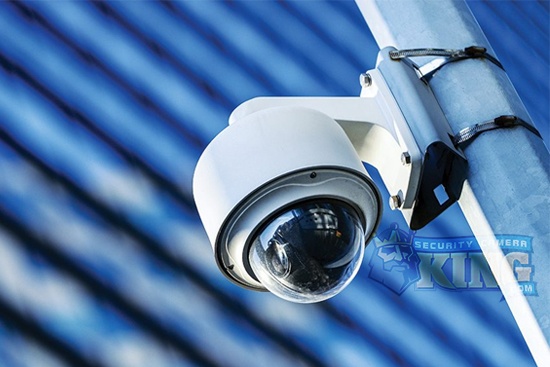Surveillance and security in the modern world have a much higher need for products equipped with long-distance recording features than in previous years. This is only one of the key advantages to IP surveillance camera systems. The footage obtained is also much better overall. Remote accessibility and the integration of intelligent video analytics are other primary benefits. So what exactly are the reasons more businesses and private homes are choosing IP surveillance cameras over the analog CCTV systems of the past? Let’s take a look at some obvious pros and cons.
3 Pros of IP Surveillance Cameras
Pro #1: Higher Resolution & Long Range Security Cameras
The camera resolution is one of the first key factors to consider for anyone looking to upgrade their security system. High resolution surveillance footage increases identifying details and is all around more useful in emergency situations. If your security camera isn’t capable of yielding clear, usable footage then it is nothing more than a potential deterrent to amateur criminals.
IP surveillance cameras are well-known for delivering better images altogether than coax security cameras. Starting as low as 1.3 Megapixels, there are IP cameras on the market that go up as high as 30 MP. And in theory, there’s no real limit to how high the resolution can go.
This is especially significant for long range night vision security cameras, which monitor properties over large distances. When it comes to features like thermal imaging, facial recognition, and motion detection, IP security cameras easily edge out the lower performing coax-based security cameras.
Pro #2: Wireless Connections & Remote Accessibility
The installation process for security camera systems often means dealing with thick concrete, plaster, walls, and other objects in the way. Wireless IP cameras provide a simple solution to this common problem. Instead of making access holes for multiple cables, wireless IP surveillance cameras communicate with each other over a network via centralized access points. Though there are coax cameras capable of wireless connectivity, they still need encoders and that process can be costly.
With POE support, IP surveillance cameras can even be added to previously existing networks. The added functionality of long distance remote accessibility is another primary advantage. This allows both users and monitors to view live camera feeds in real time from a remote location via any network connected device. So if you have a smartphone, tablet, or computer connected to the internet, you can see what the camera sees.
Pro #3: High-Efficiency Video Coding (HEVC)
The latest compression standard is known as High Efficiency VIdeo Coding (HEVC) or called H.265. The previously used, older H.264 standard is still used by coax cameras. H.265 is a substantially better video encoder, working about twice as fast as its predecessor while reducing the amount of bandwidth and storage consumed.
This can be seen by the seamless transition for high-resolution video quality during playback across various applications. It also gives users the chance to use Ultra H.265, which is capable of scaling streaming feeds in a resolution as high as 8192 x 4320. This provides improved resolution precision and increases transparency both when viewing and recording live movement or animated objects.
Read 7 Ways IP Security Camera Systems are Changing CCTV for more useful information.
3 Cons of Analog CCTV Systems
Con #1: Lower Resolution
If the image that comes to mind when you hear the term CCTV is of something dark, grainy, and hard to decipher, then you are probably thinking of analog CCTV systems using coax-based security cameras. Analog CCTV cameras are notorious for delivering poor, low-quality surveillance footage that makes identifying even simple details difficult. This includes monitoring, recording, and footage playback.
One reason for this is the low megapixels available in coax security cameras. They typically start as low as 1 MP and generally max out at 4 MP for recording. Though these cameras are bought because they are often cheaper, the inability to actually use the footage in the case of a theft or robbery only means you pay the difference later.
Con #2: Position Restrictions
Analog security cameras user a DVR or a VCR to convert the data into playback footage. This connection highly restricts where you can place them and the cost of long cables can be extremely expensive. Worse still, the further away from the DVR is from the analog camera, the higher the risk of obtaining consistent footage due to the potential breach in connection. It also makes adding more analog cameras to your CCTV system much more difficult, if not impossible.
Con #3: Decreased Range & Reduced Quality
It’s already been stated that the overall resolution quality for analog cameras is significantly worse than its IP surveillance counterparts. The low-quality resolution becomes increasingly worse the further you get away from its position. This means having an extremely limited range in overall surveillance distance. In other words, if something happens even 100 feet from the camera, it could be indistinguishable or missed entirely.
To combat this, you’ll need to add more analog cameras to your CCTV system. The more cameras you add, the more DVRs you’ll need. The more DVRs, the more storage space you’ll need. And the more cables you’ll need. Then there’s installation equipment or services. The list goes on and it is easy to see that – even if the initial cost of the coax security camera is impressively low – the overall cost for products, services, and/ or labor will come out to the same (if not more) than the cost of a single long-range IP surveillance camera.
Visit Security Camera King to shop for IP security cameras online or contact us at 866-573-8878 if you have any questions.
Facebook | Twitter | Google+ | YouTube













